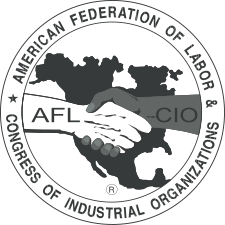
Back الاتحاد الأمريكي للعمل ومؤتمر المنظمات الصناعية Arabic Амерыканская федэрацыя працы — Кангрэс вытворчых прафсаюзаў Byelorussian American Federation of Labor and Congress of Industrial Organizations German AFL-CIO Esperanto AFL-CIO Spanish Ameerika Tööföderatsioon – Tööstusorganisatsioonide Kongress Estonian فدراسیون کارگران آمریکا و کنگره سازمانهای صنعتی Persian AFL-CIO Finnish Fédération américaine du travail - Congrès des organisations industrielles French AFL-CIO Galician
American Federation of Labor and Congress of Industrial Organizations | |
 | |
| Formation | December 5, 1955 |
|---|---|
| Merger of | |
| Type | Trade union center |
| Headquarters | Washington, DC, US |
| Location |
|
| Membership | 12,471,480[1] (2022) |
President | Liz Shuler |
Secretary-treasurer | Fred Redmond |
| Secessions | Change to Win Federation |
| Affiliations | International Trade Union Confederation |
| Website | aflcio |
The American Federation of Labor and Congress of Industrial Organizations (AFL-CIO) is a national trade union center that is the largest federation of unions in the United States. It is made up of 61 national and international unions, together representing nearly 15 million active and retired workers.[1][2] The AFL-CIO engages in substantial political spending and activism, typically in support of progressive and pro-labor policies.[3]
The AFL-CIO was formed in 1955 when the American Federation of Labor and the Congress of Industrial Organizations merged after a long estrangement. Union membership in the US peaked in 1979, when the AFL-CIO's affiliated unions had nearly twenty million members.[4] From 1955 until 2005, the AFL-CIO's member unions represented nearly all unionized workers in the United States. Several large unions split away from AFL-CIO and formed the rival Change to Win Federation in 2005, although a number of those unions have since re-affiliated, and many locals of Change to Win are either part of or work with their local central labor councils. The largest unions currently in the AFL-CIO are the Service Employees International Union (SEIU), with 2 million members, American Federation of Teachers (AFT) with approximately 1.7 million members,[5] American Federation of State, County and Municipal Employees (AFSCME), with approximately 1.4 million members,[6] and United Food and Commercial Workers with 1.2 million members.[7]
- ^ a b US Department of Labor, Office of Labor-Management Standards. File number 000-106. Report submitted September 28, 2022.
- ^ "Our Unions and Allies". aflcio.org. AFL-CIO. Retrieved January 17, 2025.
{{cite web}}: CS1 maint: url-status (link) - ^ Timothy J. Minchin, Labor under Fire: A History of the AFL–CIO Since 1979 (U of North Carolina Press, 2017).
- ^ Jillson, Cal (July 2007). American Government: Political Change and Institutional Development. Psychology Press. ISBN 978-0415960779.
- ^ US Department of Labor, Office of Labor-Management Standards. File number 000-012. Report submitted September 28, 2020.
- ^ US Department of Labor, Office of Labor-Management Standards. File number 000-289. Report submitted March 30, 2021.
- ^ US Department of Labor, Office of Labor-Management Standards. File number 000-056. Report submitted March 25, 2021.